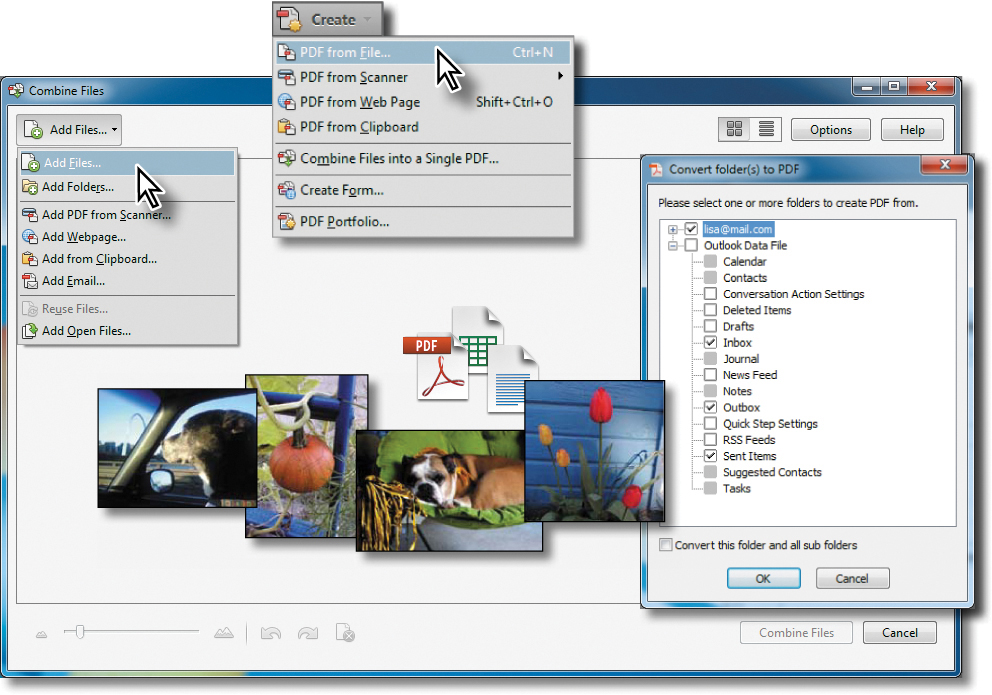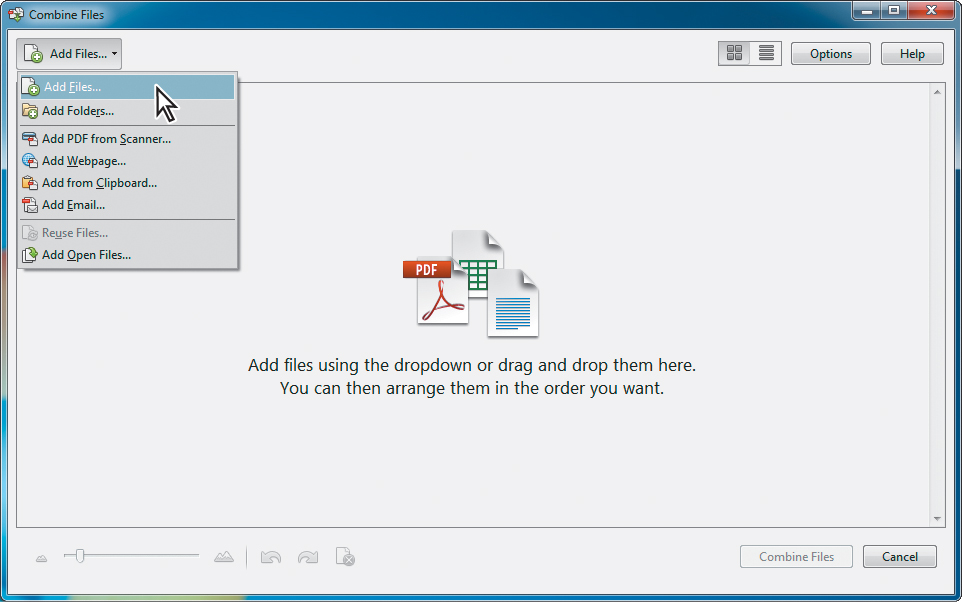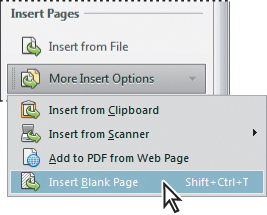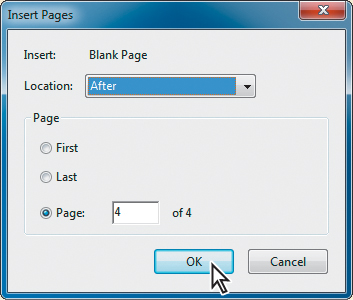2. Creating Adobe PDF Files
Lesson overview
In this lesson, you’ll do the following:
• Convert a TIFF file to Adobe PDF using the Create command.
• Convert a file to Adobe PDF using the authoring application’s Print command.
• Convert multiple documents into a single PDF file.
• Explore the Adobe PDF settings used to convert files to Adobe PDF.
• Reduce the size of a PDF file.
• Scan a paper document into Acrobat.
• Convert images into searchable text.
• Convert email messages to Adobe PDF.
• Convert web pages to Adobe PDF from Acrobat and directly from Internet Explorer (Windows) or Mozilla Firefox.
This lesson will take approximately 60 minutes to complete. Copy the Lesson02 folder onto your hard drive if you haven’t already done so.
You can easily create PDF files from existing files, such as Microsoft Word documents, web pages, scanned documents, and images.
About creating Adobe PDF files
You can convert a variety of file formats to Adobe PDF, preserving all the fonts, formatting, graphics, and color of the source file, regardless of the application and platform used to create it. You can create PDFs from images, document files, websites, scanned paper documents, and clipboard content.
If the document you want to convert to PDF is open in its authoring application (for example, a spreadsheet is open in Excel), you can usually convert the file to PDF without opening Acrobat. But if Acrobat is already open, you don’t have to open the authoring application to convert a file to PDF.
When you create a PDF, consider file size and quality (image resolution, for example). When such factors are critical, use a method that allows you to control conversion options. Dragging and dropping files on the Acrobat icon to create PDF files is fast and easy, but if you want more control over the process, use another method, such as using the Create button in Acrobat or the Print command in the authoring application. After you specify conversion settings, the settings apply across PDFMaker, Acrobat, and Acrobat Distiller until you change them.
Lesson 6, “Using Acrobat with Microsoft Office Files (Windows),” describes how to create Adobe PDF files directly from a variety of Microsoft Office files using PDFMaker in Windows. Lesson 7, “Combining Files,” covers the conversion of multiple file types as you combine files into a single PDF document. In Lesson 13, “Using Acrobat in Professional Printing,” you’ll learn how to create press-quality PDF files.
When you’re creating a PDF from within Acrobat, you must have the application that created the original file installed on your system.
If the security settings applied to an Adobe PDF file allow it, you can also reuse the content of the document. You can extract content for use in another authoring application, such as Microsoft Word, or you can reflow the content for use with handheld devices or screen readers. The success with which content can be repur-posed or reused depends very much on the structural information contained in the PDF file. The more structural information a PDF document contains, the more opportunities you have for successfully reusing the content, and the more reliably a document can be used with screen readers. (For more information, see Lesson 3, “Reading and Working with PDF Files.”)
Using the Create command
You can use the Create command in Acrobat to convert a variety of different file formats to Adobe PDF.
You’ll convert a single TIFF file to an Adobe PDF file. You can use this same method to convert a variety of both image and non-image file types to Adobe PDF.
1. Start Acrobat.
2. Do one of the following:
• Click Create PDF in the Welcome screen.
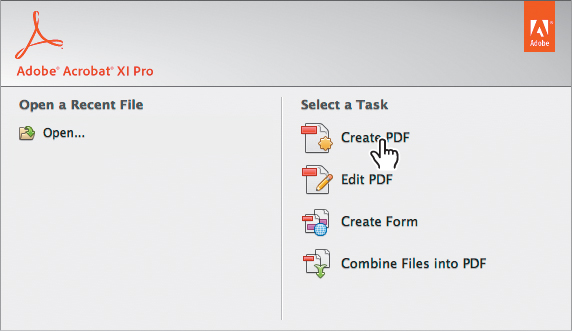
• Click the Create button on the Quick Tools toolbar, and choose PDF From File. (In Mac OS, the toolbars are available only if you already have a document open.)
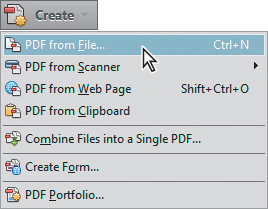
• Choose File > Create > PDF From File.
3. In the Open dialog box, choose TIFF from the file format (Windows) or Show (Mac OS) menu. (The menu lists all the file types that can be converted using this method.)
4. Navigate to the Lesson02 folder on your hard drive.
5. Click Settings to open the Adobe PDF Settings dialog box.
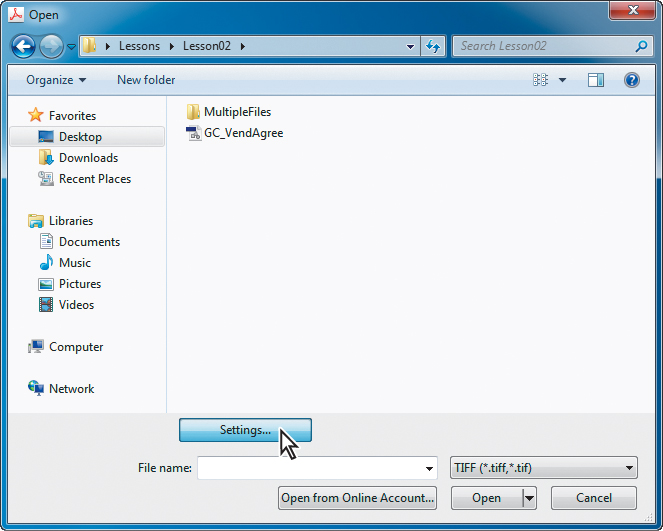
In the Adobe PDF Settings dialog box, you can choose the compression settings for color, grayscale, and monochrome images, and the color management options used when the file is converted to Adobe PDF. Resolution is determined automatically.
6. Click Cancel to leave the options unchanged for now.
You can also review and edit the settings used to convert your files to PDF in the Convert To PDF panel of the Preferences dialog box.

7. In the Open dialog box, select the GC_VendAgree.tif file, and click Open.
Acrobat converts the TIFF file to Adobe PDF and opens the PDF file automatically.
8. Click the Fit One Full Page button (![]() ) on the Common Tools toolbar so that you can see the entire agreement.
) on the Common Tools toolbar so that you can see the entire agreement.
Notice that the handwritten note that the signer of the agreement has added is preserved in the Adobe PDF file.
9. Choose File > Save As, name the file GC_VendAgree1.pdf, and save it in the Lesson02 folder. Then choose File > Close to close the PDF file.
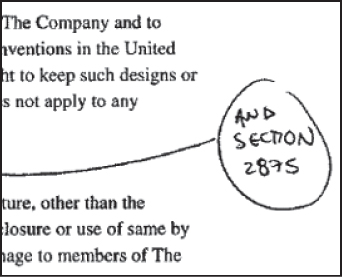
Dragging and dropping files
You can also create Adobe PDF files from many documents simply by dragging the file onto the Acrobat icon or into the document pane in Acrobat (Windows). Acrobat uses the conversion settings you specified the last time you converted a file.
Experiment with dragging the RoadieDog.jpg, Pumpkin.jpg, LoyalFan.jpg, and Tulips.jpg files from the Lesson02 folder into the Acrobat document pane (Windows), onto the Acrobat icon on your desktop, or onto the Acrobat icon in the Dock (Mac OS). Close any open PDF files when you are finished. You can save the newly created PDF files or close them without saving.

Converting different types of files
You can use the Combine Files Into A Single PDF command on the Create menu to easily convert different types of files to Adobe PDF and combine them into one PDF file. If you’re using Acrobat Pro, you can also assemble multiple documents into a PDF Portfolio. You’ll learn more about combining files and creating PDF Portfolios in Lesson 7, “Combining Files.”
Now, you’ll convert a file to Adobe PDF and combine it with several other PDF files.
Assembling the files
First, you’ll select the files you want to combine, and specify which pages to include. You’ll combine a JPEG file with several PDF files. You’ll include only a single page from one of the PDF documents.
1. In Acrobat, choose File > Create > Combine Files Into A Single PDF. Alternatively, if you’re working in Windows or have a document open in Mac OS, you can click the Create button in the Quick Tools toolbar, and choose Combine Files Into A Single PDF.
Acrobat opens the Combine Files dialog box so that you can assemble your documents.
2. Click the Add Files button in the Combine Files dialog box, and choose Add Files from the menu.
Now you’ll select the files that you want to convert and combine. The types of files that you can convert vary depending on whether you are working in Windows or Mac OS.
3. In the Add Files dialog box, navigate to the MultipleFiles folder in the Lesson02 folder. Make sure that All Supported Formats is selected.
4. Select the Ad.pdf file. Then Shift-click the Data.pdf file to select the bottle.jpg and Data.pdf files, too.
5. Click Open (Windows) or Add Files (Mac OS).
You can add files in any order, because you can rearrange them in the Combine Files window. You can also use the Remove button to remove any unwanted files.
6. Drag the thumbnail of the bottle.jpg file to the right of the Data.pdf file.

You can convert all pages in a file, or you can select a specific page or range of pages to convert.
7. Click the plus button (+) above the Data.pdf file to see thumbnails of its pages.
8. Select the first page, and click the Remove Selected Items button (![]() ) at the bottom of the dialog box.
) at the bottom of the dialog box.

9. Remove all but the second and seventh pages of the Data.pdf file, so that you’re left with four thumbnails: Ad.pdf, Data.pdf pages 2 and 7, and bottle.jpg.
10. Click Options to specify settings for the PDF file conversion.

11. In the Options dialog box, make sure the middle icon (Default File Size) is selected for File Size, and that Single PDF is selected for File Type. Then click OK.
The Default File Size option produces a PDF file suitable for viewing and printing business documents. The Smaller File Size option optimizes files for web distribution. Use the Larger File Size option to prepare documents for high-quality printing.
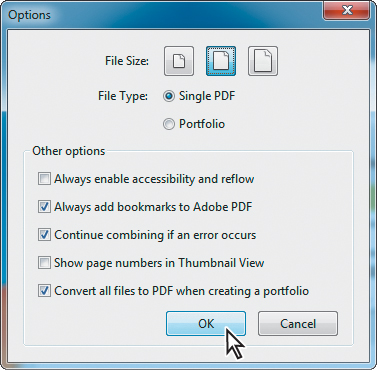
12. Click Combine Files.
Acrobat converts any native files into PDF and then consolidates all the selected files into a single file, named Binder1.pdf. The file opens automatically.
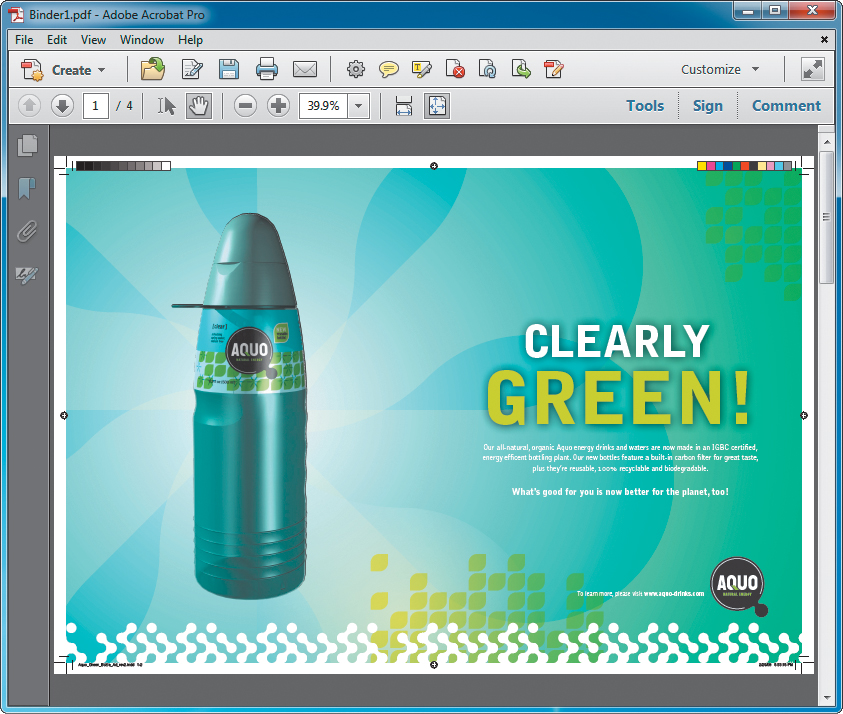
13. Use the Next Page (![]() ) and Previous Page (
) and Previous Page (![]() ) buttons to page through your consolidated documents.
) buttons to page through your consolidated documents.
14. Choose File > Save As, and rename the file Aquo.pdf. Save the file to the Lesson02 folder. Click Save.
Without leaving Acrobat, you have converted a JPEG file to Adobe PDF and combined it with other PDF files.
15. Choose File > Close to close the file.
Using PDFMaker
When you install Adobe Acrobat XI, the installer adds Acrobat PDFMaker buttons or menu commands to supported applications, including Microsoft Office applications (Windows only), Google Chrome (Windows), Mozilla Firefox, Autodesk AutoCAD, and others. PDFMaker options vary from one application to another, but they always give you the ability to quickly create a PDF file from the source application file. Depending on the application, you can also use PDFMaker to add bookmarks, tag the PDF document to make it more accessible, add security features, or include layers.
For specific information about using PDFMaker in Office for Windows, see Lesson 6, “Using Acrobat with Microsoft Office Files (Windows).” To use PDFMaker in Microsoft Outlook or Lotus Notes, see “Converting email messages to PDF (Windows)” later in this lesson. To use PDFMaker in Firefox, Chrome, or Internet Explorer, see “Converting web pages to Adobe PDF” later in this lesson.
Using the Print command to create Adobe PDF files
As you saw earlier in this lesson, you can easily create Adobe PDF files using the Create command, the Create button in the toolbar, or the Combine Files command. However, you can also create an Adobe PDF file from a file in almost any application by using the application’s Print command with the Adobe PDF printer (Windows) or the Save As Adobe PDF option (Mac OS).
Printing to the Adobe PDF printer (Windows)
The Adobe PDF printer isn’t a physical printer like one that might sit in your office. Rather, it is a simulated printer that converts your file to Adobe PDF instead of printing it to paper. The printer name is Adobe PDF.
You’ll convert a text file to Adobe PDF using the Print command with the Adobe PDF printer. You can use this technique from almost any application, regardless of whether the application has built-in features for creating PDF files. You should be aware, however, that the Adobe PDF printer creates untagged PDF files. (A tagged structure is required for reflowing content to a handheld device and is preferable for producing reliable results with a screen reader.)
Steps may vary depending on whether you are using Windows XP, Windows 7, or Windows 8. These steps assume that you are using Windows 7.
1. From your desktop, navigate to the Lesson02 folder, and select the Memo.txt file.
2. Choose File > Open With > WordPad. Or right-click the file, and choose Open With >WordPad. The text file opens in WordPad, a text editor that comes with Windows.
3. In WordPad in Windows 7, click the menu button and choose Print. In Windows XP, choose File > Page Setup, and click the Printer button.
4. Choose Adobe PDF from the list of printers. You may need to scroll to see it.
If you simply double-click the file, Windows opens it in Notepad. You can use Notepad for this exercise, but the memo may lose its formatting.
To change the settings used to convert the text file to Adobe PDF, click Preferences in the Print dialog box or Properties in the Page Setup dialog box. For more information, see the “Adobe PDF Presets” sidebar later in this lesson.
5. In Windows 7, click Print. If you’re using Windows XP, click OK twice to close the Page Setup dialog box and return to the memo, and then choose File > Print and click Print.
6. Save the file using the default name (Memo.pdf) in the Lesson02 folder, and click Save in the Save PDF File As dialog box.
7. If the PDF file doesn’t open automatically, navigate to the Lesson02 folder, and double-click the Memo.pdf file to open it in Acrobat. When you have reviewed the file, close it and quit WordPad.
The Adobe PDF printer is an easy and convenient way to create a PDF file from almost any document. However, if you’re working with Microsoft Office files, the Create Adobe PDF buttons or the Acrobat ribbon (which use PDFMaker) let you create tagged documents and include bookmarks and hypertext links.
8. Close any open files.
Printing with the Save As Adobe PDF option (Mac OS)
In Acrobat XI for Mac OS, use the Save As Adobe PDF option in the PDF menu in the Print dialog box to print from any application.
1. From your desktop, navigate to the Lesson02 folder, and double-click the Memo.txt file.
The text file opens in a text editor such as TextEdit.
2. Choose File > Print. It doesn’t matter which printer is selected.
3. Click the PDF button at the bottom of the dialog box, and choose Save As Adobe PDF.
4. In the Save As Adobe PDF dialog box, choose an Adobe PDF Settings file, and choose your version of Acrobat (Acrobat Standard or Acrobat Pro) from the After PDF Creation menu to open the PDF file in Acrobat. Click Continue.
5. In the Save dialog box, accept the default name of Memo.pdf, and save the file to the Lesson02 folder.
6. Click Save.
If you need to create a custom PDF settings file, you can do so using Distiller. To open it in Acrobat Pro, select Acrobat Distiller in the Print Production panel in the Tools pane. For more information about creating custom PDF settings files, see Adobe Acrobat XI Help.
7. If the PDF file doesn’t open automatically, navigate to the Lesson02 folder, and double-click the Memo.pdf file to open it in Acrobat. When you have reviewed the file, close it, and quit the text editor application.
You have just converted a simple text document to an Adobe PDF document using the authoring application’s Print command.
8. Close any open files.
Reducing file size
The size of a PDF file can vary dramatically depending on the Adobe PDF settings used to create it. For example, files created using the High Quality Print preset are larger than files created using the Standard or Smallest File Size presets. Regardless of the preset used to create a file, you can often reduce the file size without having to regenerate the PDF file.
You’ll reduce the size of the Ad.pdf file.
1. In Acrobat, open the Ad.pdf file in the Lesson02/MultipleFiles folder.
2. Choose File > Save As Other > Reduced Size PDF.
3. Select Acrobat 10.0 And Later for file compatibility, and click OK.
Be sure to choose a version of Acrobat that your intended audience is likely to have.
4. Name the modified file Ad_Reduce. pdf. Click Save to complete the process.
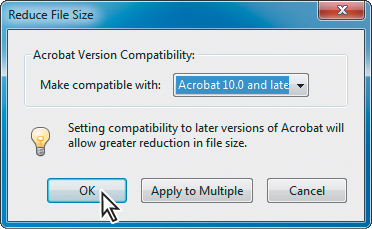
It is always a good idea to save a file using a different name so that you don’t overwrite the unmodified file.
Acrobat automatically optimizes your PDF file, a process that may take a minute or two. Any anomalies are displayed in the Conversion Warnings window. If necessary, click OK to close that window.
5. Minimize the Acrobat window. Use Windows Explorer (Windows) or the Finder (Mac OS) to open the Lesson02/MultipleFiles folder and view the size of the Ad_Reduce.pdf file. The file size is smaller than that of the Ad.pdf file.

You can repeat steps 1–5 using different compatibility settings to see how they affect file size. Note that some settings might actually increase the file size.
6. In Acrobat, choose File > Close to close your file.
Optimizing PDF files (Acrobat Pro only)
Many factors affect file size and file quality, but when you’re working with image-intensive files, compression and resampling are important. In Acrobat XI Pro, PDF Optimizer gives you greater control over file size and quality.
To access PDF Optimizer, choose File > Save As Other > Optimized PDF.
In the PDF Optimizer dialog box, you can choose from a variety of file compression methods designed to reduce the file space used by color, grayscale, and monochrome images in your document. Which method you choose depends on the kind of images you are compressing. The default Adobe PDF presets use automatic (JPEG) compression for color and grayscale images and CCITT Group 4 compression for monochrome images.
In addition to choosing a compression method, you can resample bitmap images in your file to reduce the file size. A bitmap image consists of digital units called pixels, whose total number determines the file size. When you resample a bitmap image, the information represented by several pixels in the image is combined to make a single larger pixel. This process is also called downsampling, because it reduces the number of pixels in the image. (When you downsample or decrease the number of pixels, information is deleted from the image.)
Neither compression nor resampling affects the quality of text or line art.
Scanning a paper document
You can scan paper documents to PDF from a broad range of scanners, add meta-data while scanning, and optimize your scanned PDF. In Windows, you can choose presets for black and white, grayscale, color documents, and color images. These presets optimize the quality of your scanned document. You can also define your own conversion settings.
If you do not have a scanner connected to your system, skip this exercise.
1. Insert any one-page document into your scanner, and do one of the following in Acrobat:
• In Windows: Choose File > Create > PDF From Scanner, and select a preset for your document.

If Acrobat does not recognize your scanner, refer to your scanner documentation for setup instructions and troubleshooting advice.
• In Mac OS: Choose File > Create > PDF From Scanner, select options in the scanning dialog box, and click Scan.
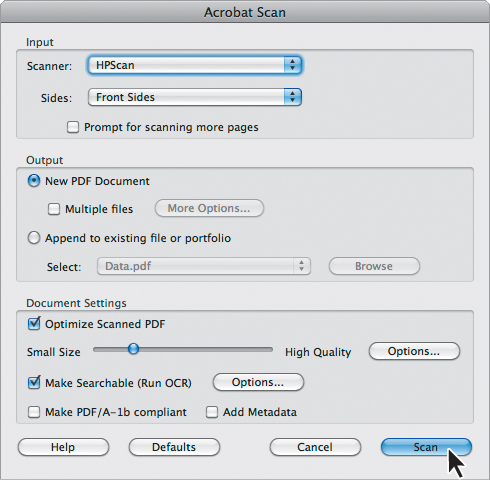
The scan occurs automatically.
2. When prompted, click OK to confirm that the scan is complete.
The PDF of the scanned document appears in Acrobat.
3. Choose File > Save, and save the scan in the Lesson02 folder as Scan.pdf.
4. In Windows, to see the settings that were used for the conversion, choose File > Create > PDF From Scanner > Configure Presets. In this dialog box, you can specify a number of options, including single- or double-sided scanning, paper size, whether to prompt for more pages, file size, application of optical character recognition, and addition of metadata in the Document Properties dialog box. Click Close to exit the dialog box without making any changes.
5. Choose File > Close to close your document.
Making scanned text editable and searchable
When you convert a file from an application such as Microsoft Word or Adobe InDesign to PDF, the text is fully editable and searchable. However, text in image files, whether scanned documents or files saved in an image format, is not editable and searchable. Using OCR (optical character recognition), Acrobat analyzes the image and replaces portions of it with discrete characters. It also identifies characters it may have analyzed incorrectly.
Acrobat can perform OCR automatically when you scan images. Just make sure Make Searchable is selected in the scanner preset (Windows) or Acrobat Scan dialog box (Mac OS) before you scan.
You’ll apply OCR to the TIFF file you converted earlier.
1. Choose File > Open, navigate to the Lesson02 folder, and open the GC_VendAgree1.pdf file that you saved earlier.
2. With the Selection tool (![]() ) selected in the Common Tools toolbar, move the pointer over text in the document. You can select areas in the document, but Acrobat does not specifically select any of the text.
) selected in the Common Tools toolbar, move the pointer over text in the document. You can select areas in the document, but Acrobat does not specifically select any of the text.
3. Open the Tools pane, and click Text Recognition to open its panel.
4. In the Text Recognition panel, click In This File. Acrobat displays the Recognize Text dialog box.
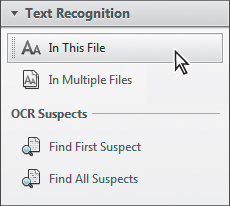
5. Make sure Current Page is selected in the Pages area of the dialog box. Then click Edit to edit the settings for the conversion.
6. In the Recognize Text - General Settings dialog box, choose ClearScan from the PDF Output Style menu.

By default, Acrobat converts the document into a searchable image. You can use this setting to convert documents, but ClearScan often provides more robust, accurate text conversion.
Using ClearScan converts the file to include scalable text and graphics, so that you can edit both in Acrobat.
7. Click OK to close the Recognize Text - General Settings dialog box, and then click OK again to close the Recognize Text dialog box and run ClearScan.
Acrobat converts the document.
8. With the Selection tool, select a word on the page. Acrobat has converted the image to editable, searchable text.
9. Click Find First Suspect in the Text Recognition panel. Acrobat searches the document and identifies any words that may have been converted incorrectly. If it finds any suspect words, you can examine them and correct them as needed. You may also need to use the Edit Text & Images tool, found in the Content Editing panel, to address issues with spacing.
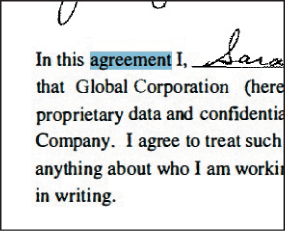
10. Click OK to close the Touchup or Adobe Acrobat dialog box, and then click Close to close the Find Element dialog box.
11. Choose File > Save As. Navigate to the Lesson02 folder, and save the file as GC_VendAgree_OCR.pdf. Then close the file.
Converting email messages to PDF (Windows)
You can convert email messages from any application using the Print command, but you have additional flexibility if you use Acrobat PDFMaker in Microsoft Outlook or Lotus Notes (Windows only). You’ll use your own email files in this exercise. If you don’t use either of these applications, you can skip this exercise.
It can be useful to save email messages in a form that is independent of your email application, either for archival purposes or just for the convenience of having a more portable and easily searchable file. PDFMaker adds buttons and commands to the Outlook and Lotus menus and toolbars that convert individual messages or email folders to Adobe PDF.
If you don’t see the Acrobat button or commands in Outlook or Lotus Notes, consult “Show or activate PDFMaker in Microsoft Office and LotusNotes” in Adobe Acrobat XI Help.
Converting email folders (Acrobat Pro)
At the completion of any personal or business project, you’ll often have a folder or several folders full of project-related email messages. With Acrobat Pro, you can easily convert these folders to a fully searchable Adobe PDF file that is completely independent of your email application.
Each email message in the folder is converted as a separate file and saved by default in a PDF Portfolio.
1. Select a folder:
• In Outlook 2010, click Selected Folders on the Adobe PDF ribbon, and choose Create New PDF.
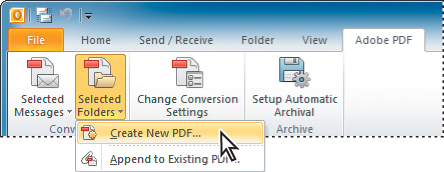
• In earlier versions of Outlook, click Create Adobe PDF From Folders.
• In Notes, click Convert Selected Folder(s) To Adobe PDF in the toolbar.
To save time, select folders that don’t contain many messages for this exercise.
2. In Outlook, in the Convert Folder(s) To PDF dialog box, you can select additional folders that you want to convert. Use the Convert This Folder And All Sub Folders option to automatically include all subfolders. Alternatively, expand the folder and manually select the required subfolders. We selected the Inbox folder and left the Convert This Folder And All Sub Folders option unselected. Click OK.
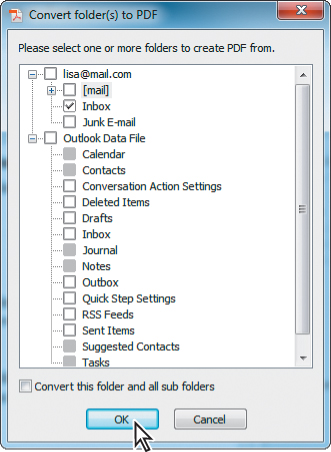
3. In the Save Adobe PDF File As dialog box, click Save to save the PDF file in the Lesson02 folder under the email folder name (Inbox.pdf). You may need to allow access to the email application program.
Your converted email messages open automatically in a PDF Portfolio in Acrobat.
Setting up automatic archiving
Automatically backing up your email messages is easy with Acrobat.
1. Click Setup Automatic Archival:
• In Outlook 2010, click Setup Automatic Archival in the Adobe PDF ribbon.

• In earlier versions of Outlook, choose Adobe PDF > Setup Automatic Archival.
• In Lotus Notes, choose Actions > Setup Automatic Archival.
2. In the Acrobat PDFMaker dialog box, click the Automatic Archival tab, and select Enable Automatic Archival.
Now you’ll specify how often the backup operation will run. You’ll set the options to back up your email weekly on Saturday at 12:00 PM.
3. For Frequency, select Weekly, and choose Saturday from the adjacent menu.
4. For Run At, choose 12:00 PM. Use the arrow keys to change the time increments, or you can type new values for the hours, minutes and AM/PM entries. You’ll leave the other options at their default values.
The Embed Index For Faster Search option, on the Settings tab, is useful when you archive folders containing many messages. This option creates an index for the entire email collection. Searching this index is faster than searching PDF files one by one.
5. If you’re using Acrobat Pro, click the Settings tab, and then select Output Adobe PDF Portfolio When Creating A New PDF File to merge the files into a PDF Portfolio. Deselect this option to merge the pages into a single PDF.
6. On the Automatic Archival tab, click Add to select the folders to archive.
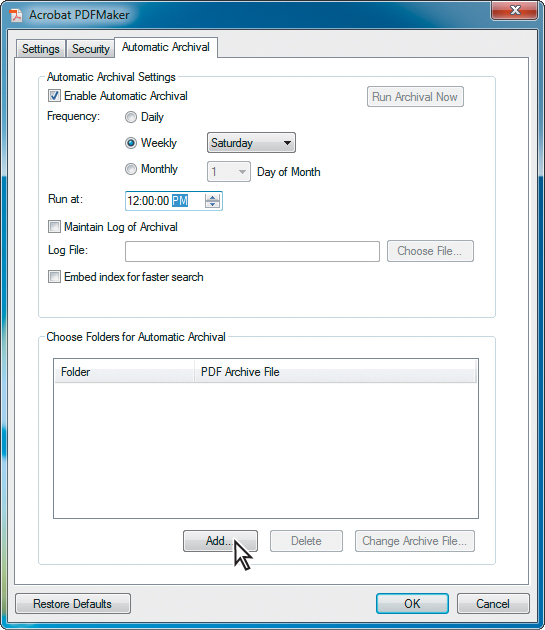
7. In the Convert Folder(s) To PDF dialog box, select the folders to be archived. We selected the Inbox folder, the Outbox folder, and the Sent Items folder. Expand any folders that have subfolders (indicated by a plus sign next to the folder name) to verify that you want to convert all the subfolders.
If you select the Convert This Folder And All Sub Folders option, you will automatically archive any and all folders in the Inbox. If you don’t want to convert all subfolders, you must deselect this option and then manually deselect subfolders that you don’t want to convert.
8. When you have finalized your selection, click OK, and enter a name for the archive file in the Save PDF Archive File As dialog box. (We saved the archive file in the Lesson02 folder using the name EmailArc.) Then click Open.
9. Click OK to finish. Your email files in the specified folders will be automatically archived every Saturday at 12:00 PM.

Be aware that this archiving process will overwrite the archive file from the previous week.
In order to see what the archive file looks like, you can run an archive operation now.
10. Click Setup Automatic Archival in the Adobe PDF ribbon (Outlook 2010), choose Adobe PDF > Setup Automatic Archival (earlier versions of Outlook), or choose Actions > Setup Automatic Archival (Lotus Notes). Then, in the Acrobat PDFMaker dialog box, click the Automatic Archival tab, and click Run Archival Now. Your PDF files are automatically created and stored in the named file.

At any time, you can add or remove folders from the automatic archival process using the Add and Delete buttons in the Automatic Archival tab of the Acrobat PDFMaker dialog box. You can change the name and/or location of the archive file using the Change Archival File button in this same dialog box.
11. When you are finished, close any open PDF files, and close Outlook or Lotus Notes.
Converting web pages to Adobe PDF
You can convert or “capture” an entire web page or several levels of a multipage website. From Internet Explorer and Firefox, you can also capture only selected content on a web page. You can define a page layout, set display options for fonts and other visual elements, and create bookmarks for web pages that you convert to Adobe PDF. The HTML file and all associated files—such as JPEG images, cascading style sheets, text files, image maps, and forms—are included in the conversion process, so the resulting PDF behaves much like the original web page.
Because converted web pages are in Adobe PDF, you can easily save them, print them, email them to others, or archive them for your own use.
Converting web pages from within Acrobat
Because web pages are updated on a regular basis, when you visit the web pages described in this lesson, the content of the pages may have changed, and you may have to use links other than those described here. However, you should be able to apply the steps in this lesson to virtually any links on any website. If you are working inside a corporate firewall, for example, you might find it easier to complete this exercise substituting an internal site for the Adobe Press site or the Peachpit site.
Before you can download and convert web pages to Adobe PDF, you must be able to access the web.
Now you’ll enter a URL in the Create PDF From Web Page dialog box and convert some web pages.
1. Choose File > Create > PDF From Web Page.
2. For URL, enter the address of the website you’d like to convert. (We used the Adobe Press website at http://www.adobepress.com.)
3. Click the Capture Multiple Levels button.

You control the number of converted pages by specifying the levels of site hierarchy you wish to convert, starting from your entered URL. For example, the top level consists of the page corresponding to the specified URL, the second level consists of pages linked from the top-level page, and so on. Consider the number and complexity of pages you may encounter when downloading more than one level of a website at a time. A complex site can take a very long time to download. Therefore, we don’t recommend selecting Get Entire Site for most websites. In addition, downloading pages over a dial-up modem connection will usually take much longer than downloading them over a high-speed connection.
4. Make sure that the Get Only option is selected, and that 1 is selected for the number of levels.
5. Select Stay On Same Path to convert only pages that are subordinate to the URL you entered.
6. Select Stay On Same Server to download only pages on the same server as the URL you entered.
7. Click Create.
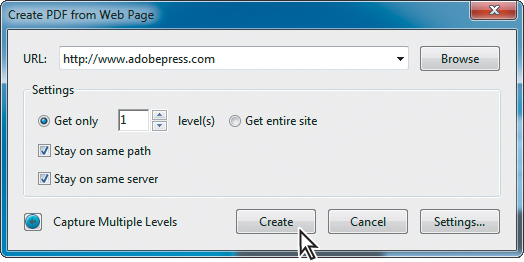
The Download Status dialog box displays the status of the download in progress. When downloading and conversion are complete, the converted website appears in the Acrobat document window, with bookmarks in the Bookmarks panel.
In Windows, if you’re downloading more than one level of pages, the Download Status dialog box moves to the background after the first level is downloaded.
If Acrobat cannot download any linked material, it returns an error message. Click OK to clear any error message.
8. Click the Bookmarks icon in the navigation panel to see the bookmarks Acrobat created.
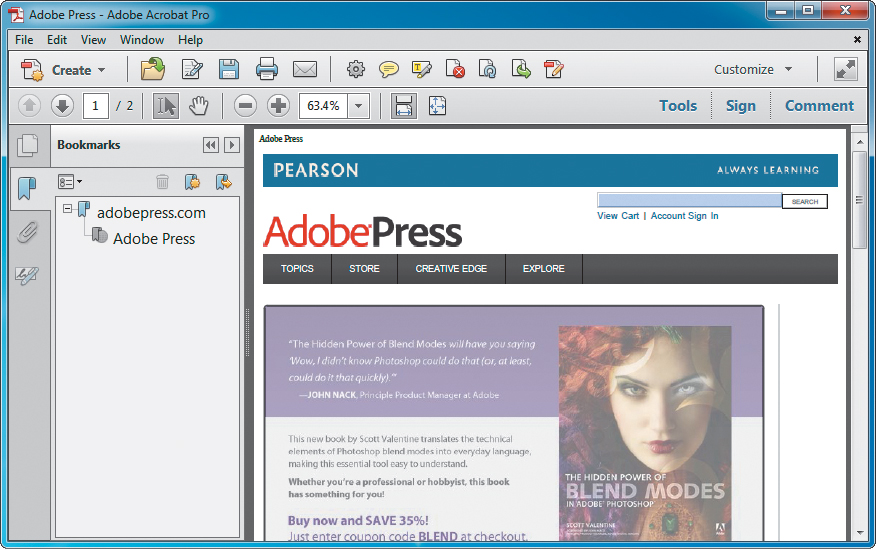
9. Click the Fit One Full Page button (![]() ) on the Common Tools toolbar to fit the view of the converted web page to your screen.
) on the Common Tools toolbar to fit the view of the converted web page to your screen.
10. Use the Next Page (![]() ) and Previous Page (
) and Previous Page (![]() ) buttons to move through the pages.
) buttons to move through the pages.
11. Choose File > Save As, name the file Web.pdf, and save it in the Lesson02 folder.
The converted website is navigable and editable just like any other PDF document. Acrobat formats the pages to reflect your page-layout conversion settings as well as the look of the original website.
Downloading and converting linked pages
When you click a web link in the Adobe PDF version of the web page that links to an unconverted page, you can download and convert that page to PDF, attaching it to the PDF document you created.
1. Navigate through the converted website until you find a web link to a page that wasn’t included in your original conversion. We used a link below the AdobePress title bar. (The pointer changes to a pointing finger when positioned over a web link, and a tool tip displays the URL of the link.)
2. Right-click (Windows) or Control-click (Mac OS) the link, and choose Append To Document from the context menu.
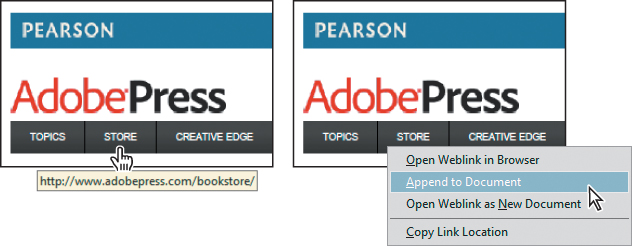
The Download Status dialog box appears again. When the download and conversion are complete, Acrobat displays the linked page, and adds a bookmark for the page to the Bookmarks list.
3. Choose File > Save As, rename the file Web1.pdf, and save it in the Lesson02 folder.
4. When you’re finished looking at your converted web pages, quit Acrobat.
Now you’ll convert web pages directly from Internet Explorer or Firefox.
Converting web pages in a web browser
If you’ve ever had the frustrating experience of printing a web page from your browser only to discover portions of the page missing, you’ll appreciate the Acrobat feature that lets you create and print an Adobe PDF version of the web page without ever leaving your browser. You can use PDFMaker in Internet Explorer (Windows), Chrome (Windows), or Firefox (Windows or Mac OS) to convert the currently displayed web page to an Adobe PDF file. When you print a converted web page from Acrobat, the page is reformatted to a standard page size, and logical page breaks are added.
First you’ll explore the preferences used to create Adobe PDF pages from your web pages, and then you’ll convert a page.
1. Open Firefox, Chrome, or Internet Explorer, and navigate to a favorite web page. We opened the Peachpit Press home page at http://www.peachpit.com.
2. Click the arrow next to the PDF button (![]() ) in Internet Explorer or Firefox; click the PDF button in Chrome. Then choose Preferences from the menu. You can create bookmarks, include headers and footers, add tags, and change page layout features such as orientation.
) in Internet Explorer or Firefox; click the PDF button in Chrome. Then choose Preferences from the menu. You can create bookmarks, include headers and footers, add tags, and change page layout features such as orientation.

If you don’t see the PDF button in Internet Explorer, click the Tools icon, choose Manage Add-ons, and then make sure the Adobe Acrobat Create PDF Toolbar is enabled. In Firefox, choose Tools > Add-ons, and make sure the Adobe Acrobat Create PDF 2.0 extension is enabled. In Chrome, click the menu button, choose Tools > Extensions, and make sure the Adobe Acrobat - Create PDF extension is enabled.
PDFMaker add-ons are installed with Acrobat. If you install a browser application after installing Acrobat, reinstall Acrobat to install the add-on.
3. Click Cancel to exit the dialog box without making any changes.
Now you’ll convert the web page to Adobe PDF.
4. Click to display the PDF menu, and choose Convert Web Page To Adobe PDF.
5. In the Convert Web Page To Adobe PDF dialog box, navigate to the Lesson02 folder. Enter a filename (we used PeachpitHome.pdf). Then click Save.

The default filename used by Acrobat is the text used in the HTML tag <TITLE>. Any invalid characters in the web page filename are converted to an underscore when the file is downloaded and saved.
Your selected text is converted to PDF, and the file automatically opens in Acrobat.
6. When you are finished, close the browser, Acrobat, and any open PDF files.
Review questions
1. How can you find out which file types can be converted to Adobe PDF using the Create PDF From File command?
2. If you’re working with a file type that isn’t supported by the Create PDF From File or From Multiple Files command, how can you create a PDF file?
3. Why would you use PDFMaker to create PDF files?
4. How can you convert an image file to searchable text?
Review answers
1. Choose File > Create > PDF From File. Open the file format (Windows) or Show (Mac OS) menu in the Open dialog box to view the supported file types.
2. You can create a PDF file from almost any application by using the Print command in the source application. In Windows, select the Adobe PDF printer. In Mac OS, click the Create PDF button in the Print dialog box, and then choose Save As Adobe PDF. When you click the Print button, Acrobat creates an Adobe PDF file rather than sending your file to a desktop printer.
3. When you install Acrobat, it adds buttons or menu commands to supported applications to let you create PDF files easily from those applications using PDFMaker. PDFMaker includes options that let you customize PDF files from different applications. For example, you can create bookmarks, preserve layers, add security features, or tag documents using PDFMaker in some applications.
4. To convert an image file to searchable text, click In This File or In Multiple Files in the Text Recognition panel in the Tools pane. Then select the options you want to apply, such as whether to use ClearScan or to save the document as a searchable image.

